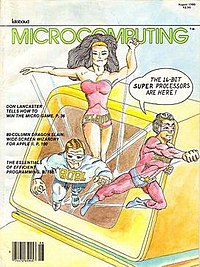
The TRS-80 Micro Computer System is a desktop microcomputer launched in 1977 and sold by Tandy Corporation through their Radio Shack stores. The name is an abbreviation of Tandy Radio Shack, Z80 [microprocessor]. It is one of the earliest mass-produced and mass-marketed retail home computers.

The Sinclair ZX80 is a home computer launched on 29 January 1980 by Science of Cambridge Ltd.. It is notable for being one of the first computers available in the United Kingdom for less than a hundred pounds. It was available in kit form for £79.95, where purchasers had to assemble and solder it together, and as a ready-built version at £99.95.
Tiny BASIC is a family of dialects of the BASIC programming language that can fit into 4 or fewer KBs of memory. Tiny BASIC was designed by Dennis Allison and the People's Computer Company (PCC) in response to the open letter published by Bill Gates complaining about users pirating Altair BASIC, which sold for $150. Tiny BASIC was intended to be a completely free version of BASIC that would run on the same early microcomputers.

The Homebrew Computer Club was an early computer hobbyist group in Menlo Park, California, which met from March 1975 to December 1986. The club had an influential role in the development of the microcomputer revolution and the rise of that aspect of the Silicon Valley information technology industrial complex.
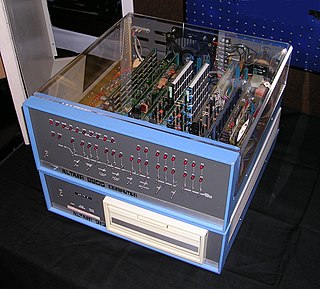
The Altair 8800 is a microcomputer designed in 1974 by MITS and based on the Intel 8080 CPU. Interest grew quickly after it was featured on the cover of the January 1975 issue of Popular Electronics and was sold by mail order through advertisements there, in Radio-Electronics, and in other hobbyist magazines. According to Harry Garland, the Altair 8800 was the product that catalyzed the microcomputer revolution of the 1970s. It was the first commercially successful personal computer. The computer bus designed for the Altair was to become a de facto standard in the form of the S-100 bus, and the first programming language for the machine was Microsoft's founding product, Altair BASIC.

The TI-99/4 and TI-99/4A are home computers released by Texas Instruments in 1979 and 1981, respectively. Based on Texas Instruments's own TMS9900 microprocessor originally used in minicomputers, the TI-99/4 was the first 16-bit home computer. The associated TMS9918 video display controller provides color graphics and sprite support which were only comparable with those of the Atari 400 and 800 released a month later. The TI-99 series also initially competed with the Apple II and TRS-80.
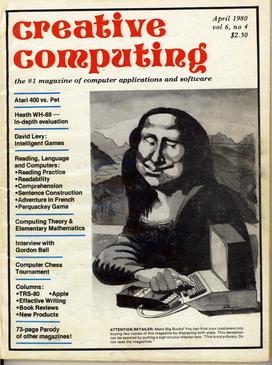
Creative Computing was one of the earliest magazines covering the microcomputer revolution. Published from October 1974 until December 1985, the magazine covered the spectrum of hobbyist/home/personal computing in a more accessible format than the rather technically oriented Byte.
Ohio Scientific, Inc., was a privately owned American computer company based in Ohio that built and marketed computer systems, expansions, and software from 1975 to 1986. Their best-known products were the Challenger series of microcomputers and Superboard single-board computers. The company was the first to market microcomputers with hard disk drives in 1977.

Practical Computing was a UK computer magazine published monthly. The magazine was published by IPC Electrical Electronic Press Ltd. The headquarters was in Sutton, Surrey. The first edition was released in August 1978 as a special computer show edition, and the second issue was October 1978. The magazine carried on to 1987 when it merged with Business Computing. In September 1989, it was renamed Management Computing.

Microchess, sometimes written as MicroChess, is a chess program developed for the MOS Technology KIM-1 microcomputer by Peter R. Jennings in 1976, and published by his company Micro-Ware. The game plays chess against the human player at a beginner level, with the player entering moves via a keyboard and the computer responding, both in a custom chess notation. The game was ported to many other microcomputers such as the TRS-80, Apple II, Commodore PET, and Atari 8-bit computers by Micro-Ware and its successor company Personal Software between 1976 and 1980, with later versions featuring graphics and more levels of play. A dedicated hardware version of the game called ChessMate was produced by Commodore International in 1978, and the game's engine was licensed to Novag for its dedicated Chess Champion Mk II chess computer in 1979.

80 Micro was a computer magazine, published between 1980 and 1988, that featured program listings, products and reviews for the TRS-80.
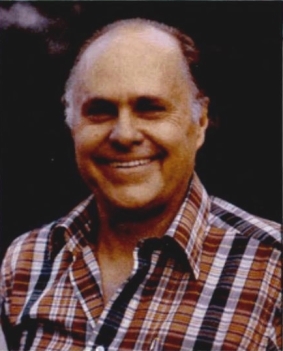
Wayne Sanger Green II was an American publisher, writer, and consultant. Green was editor of CQ magazine before he went on to found 73, 80 Micro, Byte, CD Review, Cold Fusion, Kilobaud Microcomputing, RUN, InCider, and Pico, as well as publishing books and running Instant Software.

The TRS-80 Model II is a computer system launched by Tandy in October 1979, and targeted at the small-business market. It is not an upgrade of the original TRS-80 Model I, but a new system.

The TRS-80 Model 4 is the last Z80-based home computer family by Radio Shack, sold from April 1983 through late 1991.

Home computers were a class of microcomputers that entered the market in 1977 and became common during the 1980s. They were marketed to consumers as affordable and accessible computers that, for the first time, were intended for the use of a single, non-technical user. These computers were a distinct market segment that typically cost much less than business, scientific, or engineering-oriented computers of the time, such as those running CP/M or the IBM PC, and were generally less powerful in terms of memory and expandability. However, a home computer often had better graphics and sound than contemporary business computers. Their most common uses were word processing, playing video games, and programming.

Byte was a microcomputer magazine, influential in the late 1970s and throughout the 1980s because of its wide-ranging editorial coverage.
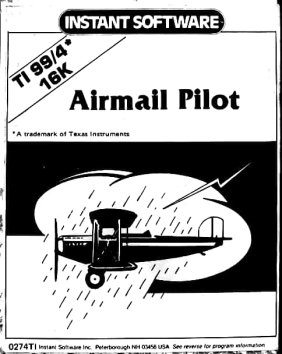
Airmail Pilot is a video game published in 1979 by Instant Software, in which the player pilots a Curtiss JN-4D "Jenny" biplane carrying mail from Columbus, Ohio to Chicago.

Martin Research Ltd., later Qwint Systems, Inc., was an American computer company founded by Donald Paul Martin in Northbrook, Illinois, United States. The company released their Mike family of modular kit microcomputers starting in 1975. These computers, spanning several models based on the Intel 8008, 8080, and Zilog Z80 microprocessors, proved very popular among hobbyists who wanted an inexpensive trainer computer.

The Baby! 1 is a transportable microcomputer released by STM Systems Inc. of Mont Vernon, New Hampshire, in late 1976. The computer was based on the MOS Technology 6502 microprocessor and came in a small enclosure that fit inside an attaché briefcase that came shipped with the computer. Byte magazine in 1985 called it the first portable microcomputer, although it more closely resembled the home computers of the 1980s such as the Commodore 64 than early laptops like the Grid Compass.
